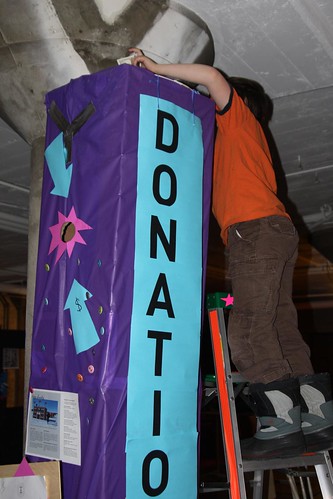 In 2010, the Children's Museum of Tacoma was getting ready to move to a new, bigger facility. Over the years, they had noticed that 50% of their visitors were coming for free or at reduced cost--whether on free days or with special passes. When they moved to the new facility, they decided they wanted to radically expand access to the museum, AND increase revenue.
In 2010, the Children's Museum of Tacoma was getting ready to move to a new, bigger facility. Over the years, they had noticed that 50% of their visitors were coming for free or at reduced cost--whether on free days or with special passes. When they moved to the new facility, they decided they wanted to radically expand access to the museum, AND increase revenue.What did they do? They went to a "pay as you will" model. Now, they encourage visitors to become mini-philanthropists, enabling inclusion for all. Charging admission is a means test, and they want everyone to be able to pass.
The Children's Museum of Tacoma is two years into their "pay as you will" model, and it looks like a success. Attendance jumped from 40,000 at their old facility to about 120,000 at the new facility. Membership has doubled (now including new perks that extend beyond free admission). Attendance by low-income families is up. And while the average amount paid by each non-member visitor is down (dropping from $6 to about $3), the attendance increase means a net revenue gain. The museum launched this new strategy with a major grant from a funder (Key Bank) that provided five years of admissions offset--enough risk capital to give the museum time to grow into the new approach. The transformation of admission fees and its impact is documented beautifully in this blog post by Jeanne Vergeront. Check it out for a lot more details and numbers.
I called the museum because I was curious to learn more about the mechanics of communicating this approach to visitors. "By donation only" can offer a wonderful sense of welcome, or it can be misleading. (Consider the ongoing lawsuits at the Metropolitan Museum on this very issue.) I wondered whether "pay as you will" might come with its own confusion and stress for families without much exposure to museums--the exact people the museum is trying to make welcome. The "pay as you will" messaging is very different, for example, from Mixed Blood Theater's "Radical Hospitality" approach, which emphasizes completely free theater experiences.
"No cost" is much more clearcut than "pay as you will." Might "pay as you will" become another museum mystery, another source of threshold fear for visitors who don't have a yardstick by which to reasonably guess what they SHOULD pay to visit?
I spoke with Chad Russell, the Administrative Coordinator at the Children's Museum of Tacoma, about their experience. He told me, "We often get asked if there is a suggested donation, what should we pay. We don’t want to put any pressure on for a suggested donation – we want you to pay what you think.”
Chad also told me:
- They have donation bins throughout the museum, so if people don't want to give much when they first walk in, they can pay somewhere else. Some people will donate more on their way out (but are not prompted to do so).
- They train their frontline staff to engage with people about WHY it is pay as you will, explaining that your donation makes it possible for other kids who couldn’t afford it, so they can come play for free. Some kids apparently come in with their piggy banks, proud that they can pay to attend the museum--because whatever they have to offer is valued as exactly enough.
- When people are stressed about how much to pay, he says, "before we went to this model, the cost was about $5 at the door." This might help more literal-minded people feel comfortable with an ambiguous system.
To me, this seems like an improvement on the norm... especially in a children's museum, which has a high number of repeat visitors (who can become familiar with the system over time). I can imagine families deciding on a value and paying it fairly consistently with little stress. I can imagine the cute rituals of kids, excited to contribute personally, proud to be part of making the museum available to all. But I can also imagine visitors being confused and stressed out--which is even worse in front of your kids.
Does "pay as you will" fundamentally change the relationship between the institution and community members with regard to the cost and perceived value of the experiences inside? There's still a transaction--or at least a conversation--at the gate. Is that a good thing, because it invites/requires people to grapple with the cost of providing these experiences? Or is it just a different wrapper on same old means test?
